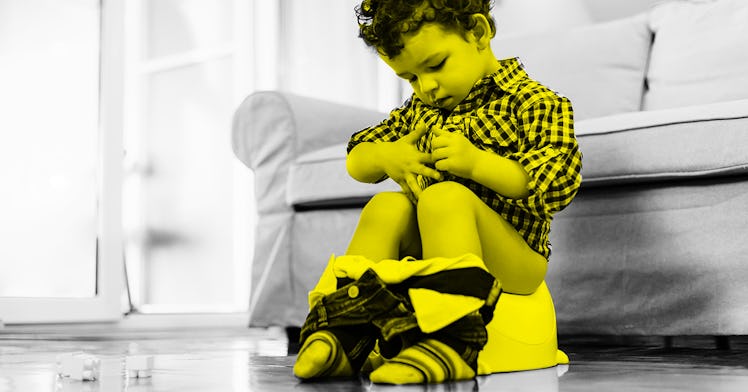We Used This Chinese Method to Potty Train Our Son in a Week
Don't get me wrong, it was weird and messy ⏤ but it worked.

For two years, my partner and I struggled with how to potty-train a boy, and we got nowhere. But a Chinese daycare’s potty-training methods managed to have him peeing in a toilet in just one week. They used “elimination communication” to potty-train toddlers. You might have encountered this method in reading about potty-training. Admittedly, the articles are right ⏤ it really does work ⏤ but they also offer a somewhat sanitized version of how it’s done and leave out some important details.
Parents in China don’t just do a few things differently ⏤ they live in an entirely different culture. And if you really want to embark on toddler potty-training the Chinese way, you’re going to have to endure a few stares along the way. Here’s what it takes:
1. Watching for Signs of Incoming Pee
Part of the secret to potty-training with “elimination communication” is watching for those little hints that your child has to use the bathroom. When the child’s too young to say anything, you have to be the one looking out for signs and rushing them to the potty before it’s too late. And that works. Kind of. I mean, that’s certainly what we did. We looked for facial expressions and twitches and made our best guess as to whether or not our son had to pee. And we were often right ⏤ like, 40 percent of the time.
This story was submitted by a Fatherly reader. Opinions expressed in the story do not reflect the opinions of Fatherly as a publication. The fact that we’re printing the story does, however, reflect a belief that it is an interesting and worthwhile read.
But what people don’t mention is that this is a hell of a lot simpler when your kid’s wearing crotchless pants. Because as useful as little facial twitches can be, it’s a whole lot easier to know an accident is coming when you can see the water hose filling up. That’s why we didn’t get our child trained until he was 2 ⏤ because we were too shy to cut holes in his pants.
2. Wearing Crotchless (Potty-Training) Pants
Babies are one of the first things you notice when you visit China. In lieu of diapers, most children move around in slitted pants: pants with big, gaping holes right in the one place you’d expect any self-respecting article of clothing to cover up. That’s the real secret to why these kids don’t wet their pants ⏤ they have crotch holes. It would be practically impossible to soil them.
For Westerners, it’s a pretty jarring sight to see a bunch of kids living the free and breezy life. But as far as our Chinese daycare was concerned, it wasn’t anywhere near as disgusting as wearing diapers. The way they see it, the worst-case scenario is that a kid wearing crotchless pants will leave a mess somewhere. If he’s outside, he might pee on the grass; if he’s indoors, you might need to grab a mop.
3. Hanging Out on the Potty
In China, there’s no cooler place to hang out with your kids than on a miniature plastic potty. It’s basically where you end up spending half of your day. As soon as a baby’s big enough to hold up his own head, they’ll plop him on the toilet every chance they get. Usually, they straddle them over the potty with their hands under their thighs. Then, when it’s time to pee, they whistle.
The point is to get the baby used to the idea that this is where they’re supposed to go to the bathroom. The whistle, meanwhile, creates a Pavlovian reaction designed to make them pee on command. It works surprisingly well. But the one thing you’ve got to prepare for is spending a lot more time hanging out on the potty. Unfortunately, it’s tough to do when you have a job. But it’s a whole lot easier if, like most Chinese couples, your grandparents live in the house.
4. Peeing in Trash Cans
In the West, we’re convinced that kids aren’t ready developmentally for potty training until they’re 2 years old. And, honestly, we’re kind of right. One-year-olds really can’t make it to the potty in time. It’s just that, in China, nobody cares where the kid pees. In fact, kids in China pee everywhere. They’ll pee in trash cans, they’ll pee on trees, and they’ll even just whip it out and pee on the sidewalk, right where everyone’s walking. And that works.
5. Deciding How Far You’re Willing to Go
I’ll be honest, we didn’t go all the way. We hung out on the potty, we let our boy pee on trees, and we even ran a one-week intensive “no pants allowed” potty training, similar to the American three-day weekend version. Because of all that, we could call our boy potty trained at 2. Butm we hadn’t been willing go all the way. We weren’t about to have our child running around outside with a hole in his pants or peeing on sidewalks as he strolled through town. Maybe if we had, we would have had him potty-trained a year earlier, before arriving in China ⏤ but we were only willing to go so far.
That’s the truth about elimination communication. It works, but there’s more to it than just technique. It takes an entire culture to make it work. And if you’re going to try in the West, you’ve got to decide just how much staring you’re willing to endure.
Mark Oliver is writer, a teacher, and a father. You can read more of his writing at mark-oliver.com.
This article was originally published on